by Matt Lollar | May 18, 2017
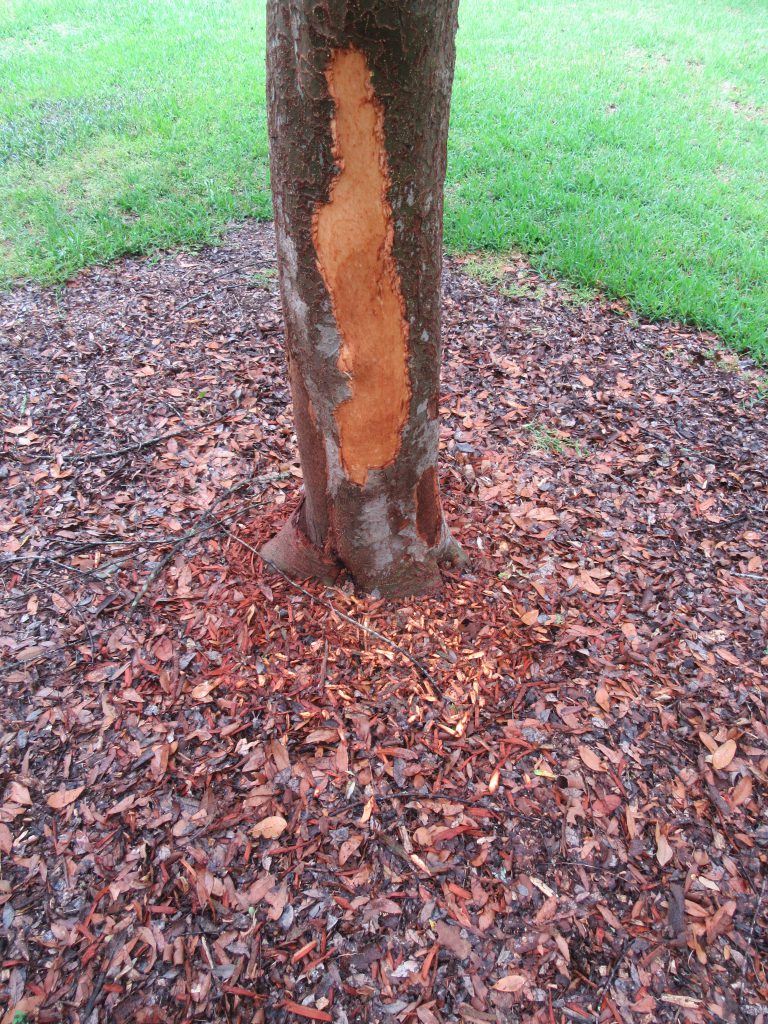
Squirrel bark stripping damage on a Chinese elm. Photo Credit: University of Florida/IFAS Extension
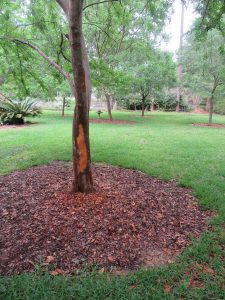
Barked stripped from the trunk of a Chinese elm. Photo Credit: University of Florida/IFAS Extension
The squirrels are at it again! This time they are stripping the bark from the trunks of my Chinese elm (Ulmus parvifolia) trees. Squirrels feed on the bark of a number of other different tree species including oaks, maples, and pecans. There are a few theories as to why squirrels feed on tree bark.
- Pregnant Females – Pregnant squirrels don’t eat prior to giving birth, but it is thought they chew on bark to help them bear the pain of pregnancy.
- Water Source – This theory isn’t very reputable due to the fact that squirrels have been seen feeding on bark come rain or shine.
- Food Source – The inner bark layer (phloem) contains sugar and nutrients which help satisfy a squirrel’s appetite.
The good news is squirrels generally do not eat enough bark to kill a tree. A squirrel will typically only strip a half inch section of bark about three inches long. However, the squirrels in my yard were much hungrier this year as you can see in the featured pictures.
Because squirrels do not usually girdle the trunk of the tree, they generally do not cause enough damage to kill a tree. However, their bark stripping habits can be unsightly in a well-maintained landscape. A few control options are available.
- Tree Wrap – Tree trunks can be wrapped with 24″ or longer aluminum flashing. Unfortunately, this option can be more unsightly than the bark stripped trunks.
- Repellents – A number of different wildlife repellents are on the market. Most repellents do not smell very good because they contain egg solids.
- Harvest – This is my favorite method of control! Make sure you follow all state and local laws.
For more information on wildlife management, please visit EDIS or The Internet Center for Wildlife Damage Management.
by Blake Thaxton | May 18, 2017
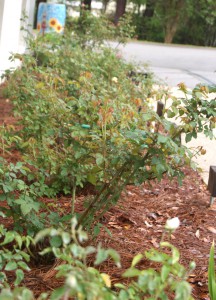
Properely pruned plants will produce vigroous new growth and ample new flowers. Even though these roses were pruned in February, soon it will be time to prune azaleas, right after they finish their bloom.
Pruning is something all homeowners and landscapers know is one of the many chores to be completed in the landscape. Everyone recognizes that pruning needs to be done on occasion, but it can be confusing to know how to prune the variety of species that can be in a landscape. There are some simplistic principles that can be followed while pruning.
Reasons for pruning:
- Training – to form good structure or good branching.
- Maintain plant vigor
- Control plant form and size
- Influence plant flowering and fruit
When to prune?
Several factors need to be considered when deciding the proper time to prune. If the plant species has a showy bloom to then consider the time of year it blooms. Some landscape plants flower on last years growths, therefore must be pruned following bloom time just before the flower buds are set for next year (ex. azaleas, spireas, and dogwoods). Plants grown with little regard to blooms, such as foliage plants like hollies, can be pruned from January to late Summer.
Learn More:
the following are great extension publications on pruning. read these to learnt he finer details of pruning so you can become an expert. Always remember to call your local extension office if you have any questions regarding pruning.
UF/IFAS – Pruning Landscape Shrubs and Trees
Alabama Cooperative Extension – Pruning Ornamental Plants
UF/IFAS Pruning website
by Molly Jameson | May 11, 2017
If you are a farmer, you have most likely heard about the Food Safety Modernization Act, or FSMA, by now. If you are not a farmer, you probably do not know that food safety regulations are going through a big change. The FSMA, which was passed in 2011, is considered the largest update to food safety regulation in over 80 years.
The proposed produce safety rule under the FSMA is very robust, establishing the minimum standards for worker training, health and hygiene, agricultural water use, animal soil amendments, on-farm domesticated and wild animals, equipment, tools, buildings, and sprout production.
But this new rule will not apply to all farmers. The commodities they produce and the value of their produce sold will ultimately dictate whether they will need to comply.
First, the rule does not apply to produce that is not a raw agricultural commodity, or commodities the Food and Drug Administration (FDA) has identified as “rarely consumed raw.” Secondly, if a farm has an average value of produce sold of $25,000 or less within the previous three years, they are also exempt.
If the farmer produces an agricultural commodity in which the rule applies and the value of their produce sold is over $25,000, it is still possible the farm will be exempt from most of the requirements.
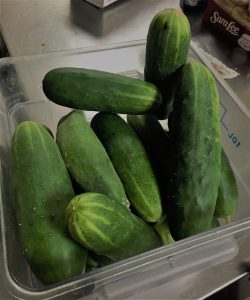
Fresh cucumbers, for example, are considered a raw commodity. But cucumbers that will undergo further processing, such as for pickling, would be eligible for exemption from the produce rule. Photo by Molly Jameson.
For instance, if the average annual monetary value of food sold directly to qualified end-users was more than the average annual value of the food sold to all other buyers within the previous three-year period, the farmer would meet the first half of exemption eligibility.
What is a “qualified end-user”, you ask? They are considered the consumers of the food, or restaurant or retail food establishment, located with the same state as the farm that produced the food (or no more than 275 miles).
But even if farmers meet the above exemption eligibility standards, they must also meet the second requirement. That is, the average annual monetary value of all food sold during the three-year period must be less than $500,000, when adjusted for inflation.
If this all sounds confusing, you are not alone! This is why the FDA developed a chart to help farmers determine if they will be exempt: Standards for Produce Safety – Coverage and Exemptions/Exclusions for Proposed 21 PART 112.
Whether farms will be exempt from the FSMA produce safety rule or not, it is always a good idea to follow good agricultural practices and to have a farm food safety plan. To learn more about food safety on farms, view the EDIS document Food Safety on the Farm: An Overview of Good Agricultural Practices.
If you are a farmer, or know someone who would benefit from having a food safety plan, the UF Small Farms Academy Extension Agents are offering a Building Your Own Farm’s Food Safety Manual Workshop in Tallahassee to help growers develop their own food safety manuals.
The workshop is tailored to fresh fruit and vegetable farms, fields, or greenhouses and is partially supported by a grant through the Florida Specialty Crops Block Grant program from the Florida Department of Agriculture and Consumer Service.
The registration fee is $35 for the first person representing a farm and $15 for an additional attendee from that farm. The workshop is limited to 20 farms on a first come, first serve basis.
The workshop will take place at the Amtrak Station, County Community Room, 918 Railroad Ave, in Tallahassee, FL, on Tuesday, May 23, 8:00 a.m. to 4:00 p.m. Register on Eventbrite by following this link: https://farmfoodsafetymanualworkshop.eventbrite.com
Please note, this class will help farmers develop their farm’s food safety manual, but it does not fulfill the new FDA FSMA one-time training requirement.
by Larry Williams | May 11, 2017
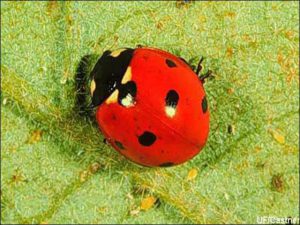
Adult Ladybug. Photo Credit: James Castner University of Florida
A number of summers ago, I noticed whiteflies on a confederate rose plant in my landscape. I considered using an insecticide to control the whiteflies but decided against doing so after taking a closer look. What I found was a population of ladybugs – eggs, larvae, pupae and adults.
Ladybug adults and larvae eat whiteflies, as well as other soft-bodied insects such as aphids. So, I waited to see what would happen.
At first I was seeing mostly adult whiteflies, which look like tiny white moths. Adult whiteflies mate and then lay eggs on the underside of leaves. The eggs hatch into flat translucent scale-like nymphs that suck the “juice” from the underside of the leaves.
Eventually, some of the leaves developed a black coating called sooty mold. As certain insects (primarily aphids, some scales and whiteflies) feed, they excrete plant sap that coats the leaves. Sooty mold then grows on this sugary sap. It’s not a pathogen. It just makes the leaves look ugly.
Knowing that the whiteflies would not kill the confederate rose, I was willing to tolerate the sooty mold and allow the ladybug population to build.
Allowing whiteflies to live on your plants may not always be the best option. But in order to have beneficial insects in your landscape, there must be some “bad” insects for them to eat.
Insects such as ladybugs, lacewings and praying mantises eat many pest insects. Encouraging these beneficial insects can allow you to reduce the amount of pesticides applied.
It’s important to learn to recognize the adult and immature stages of these beneficial insects. Ladybugs have larvae that look nothing like
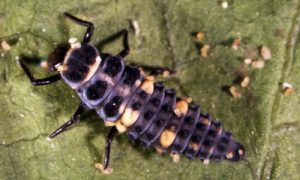
Ladybug larva. Photo credit: Aristizabal University of Florida
the adults. Some ladybug larvae look like small orange and black alligators. Others may resemble mealybugs. Many gardeners that would never kill adult ladybugs mistake their larvae as pests and kill them with insecticides.
The following UF/IFAS Extension website will help you learn to recognize many of our beneficial insects. http://edis.ifas.ufl.edu/topic_beneficial_insects
Once you find beneficial insects in your landscape, reduce or eliminate the use of insecticides. When an insecticide is needed, use environmentally friendly options such as insecticidal soaps, horticultural oils and products that contain Bacillus thuringiensis (Bt).
Sometimes a heavy stream of water from a water hose is all that is needed to remove pest insects from plants and reduce their numbers to an acceptable population.
Remember, leaving a few pest insects is a great way to attract beneficial insects. Tolerating a minor infestation and a little plant damage will benefit the helpful insects, your pocketbook and the environment.
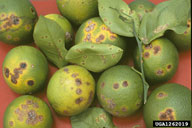
by Mary Salinas | May 11, 2017

Citrus canker symptoms on twigs, leaves and fruit. Photo by Timothy Schubert, FDACS
In November 2013, citrus canker was found for the first time in the Florida panhandle in Gulf Breeze in southern Santa Rosa County. The Florida Department of Agriculture and Consumer Services (FDACS) tested and confirmed the disease on grapefruit trees in a residential landscape. Since that time, citrus canker has been confirmed on citrus trees at 27 more locations in Gulf Breeze. To my knowledge it has not been found in any other location in the panhandle. Not yet.
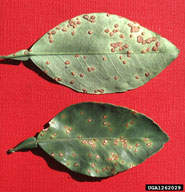
Citrus canker lesions on leaves are raised, rough and visible on both sides of the leaf. Photo by Timothy Shubert, FDACS.
Citrus canker is a serious bacterial disease that only infects citrus trees. It will not infect any other plant species nor is it a threat to human health. This highly contagious disease has no cure as yet. Severely affected trees experience substantial leaf and premature fruit drop and serve as a source for infecting other citrus in the area. The disease spreads through wind, rain and transportation of infected plant material from other locations.
We do not know how the disease came to infect trees in our region. The disease could have been spread through infected fruit or trees brought here from areas where the disease is established, such as central or south Florida.
What should you do if you suspect your citrus is infected with this disease?
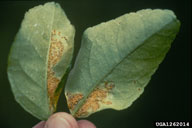
Citrus canker lesions can appear in the mines left by the citrus leafminer pest. Photo by Timothy Schubert, FDACS
- Look at Homeowner Fact Sheet: Citrus Canker for more information.
- Leave the tree in place in your yard and call the Division of Plant Industry at FDACS at 1-888-397-1517 for a free inspection and testing of your citrus trees.
- Consult your local Horticulture Extension Agent for more information and control/removal strategies.
- Proper removal of infected trees is recommended to prevent the spread of citrus canker but is not mandatory.
For more information please see:
Save Our Citrus Website
UF IFAS Gardening Solutions: Citrus
Citrus Culture in the Home Landscape
UF IFAS Extension Online Guide to Citrus Diseases









